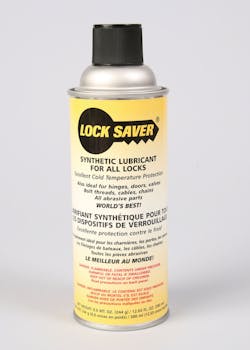Back in the July 2005 issue of The Locksmith Ledger, the Locksmithing Etc. column introduced the world to Mil-Comm Products Company’s Lock Saver brand of synthetic lubricant and cleaner products. Neil Moss of Neil’s Lock & Safe in Wasilla, Alaska, read the article, which touted Mil-Comm’s military pedigree. As an avid shooter, Neil was interested and told his wife Lindy that they ought to look at this.
When they got on the phone and called Mil-Comm for more information, they spoke with a former employee who touted the lubricant for guns, and assured Neil that it wouldn’t hurt his firearms. Neil was looking for more of a substantive answer and asked, “What’s the difference between this and some other gun lube?”
With everything that the article says about use on advanced weapon systems like the gatling guns on F-16 fighter aircraft, there’s got to be something to this technology. The voice on the other end of the phone replied, “There is a difference.”
Did I mention that he was a former employee of Mil-Comm’s?
The Moss’ interest was perked by the gun talk for a reason. They are the state directors for the Alaska Scholastic Clay Target program, which regulates and guides firearm education, training and competition across disciplines for young people across the state, spanning more than 1,000 miles.
According to Lindy, their experience on firearms quickly translated to uses applicable to the locksmith trade. Just as the kids are out there shooting high precision hardware parts at temperatures falling below -20 degrees F, outdoor locks of all types also need to brave the elements. “If you can prevent malfunctions on the firing line,” states Lindy. “You can prevent glacier silt from wreaking havoc on your lock parts.”
In fact, that very fine dust that is in the air up there, and down through Canada, gets into tight crevices, clogging up everything from springs to tumblers. Lindy added that T-handle locks and mailboxes tend to need a lot of care.
Lindy explained that for years, people would come into the shop with guns covered in all kinds of bad stuff. The guns would sit overnight after a treatment of Lock Saver and it would break down the buildup.
“Lock Saver salvages so many locks too,” Lindy explained. “We always go out on a service call with a can of Lock Saver, and squirt a little where it’s needed. Black graphite residue usually comes dripping out and we tell customers to never use that stuff again.”
On a personal note, Lindy, like most Alaskans, has issues with doors freezing. She didn’t have any of the grease on hand once, and experimented by spraying her weather stripping. It never froze again that winter.
One of Neil’s Lock & Safe’s customers would bring in a portfolio of padlocks every fall for servicing. The woman’s seasonal canoe rental business relied on padlocks, which sat around the water all summer. Neil’s conditions them with Lock Saver, and primes them with the Lock Saver grease in the lock cylinder. For the first time, she didn’t have to bring her locks back for the annual service.
Mil-Comm Products Company, Inc., founded in 1995, is a defense contractor that offers a full line of synthetic, high performance lubricants under their flagship TW25B® brand name. It is used widely in the defense community, and is the choice of many firearm manufacturers. It is also now available in the official NRA licensed Gun Care packaging. Lock Saver was introduced almost a decade ago based on the very same product technology and is available through many locksmith distributors throughout North America.
For more information, visit www.mil-comm.com.





